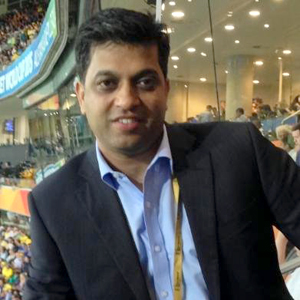The Sound Of Cricket In Sports Business Is Louder Than You May Think…
By Joe Favorito
While one of the most diverse sports weekends of the year took place last week; French Open Final, Women’s World Cup starts, NBA and Stanley Cup Finals, soccer wraps in Europe and a healthy dose of baseball in the States, the marvel of the massive draw of cricket still provides a nice comparison for engagement and audience size.
How big is cricket exactly and how important is it to a media company like ESPN? We caught up with Prasad Malmandi, Director, U.S Cricket Business for ESPN and the man with the his hand on the pulse of cricket engagement in the States to get the scoop.
Your passion for cricket goes well beyond your job. What is it about the sport that you really enjoy?
Growing up in India, even though field hockey is the national sport, cricket was and still is the most televised, watched and talked about sport in the country. That probably had a significant influence on me and after India won the cricket world cup in 1983 against the then mighty West Indies, as a nine year old I wanted to take up cricket as my profession and play for the country – both of us know where that ended.
The intense and ever-growing rivalry between India and Pakistan (or for that matter, England and Australia), the introduction of colored clothing in 1992, playing under lights – which makes the sport glamorous, adding a new format that require separate set of skills, and now the business aspect of the game have been very impressive. Having seen and been part of this evolution has been an exciting journey. In my role helping manage and drive the cricket business for ESPN, serving millions of fans in the United States is very humbling and thoroughly enjoyable.
Most people do not know the influence cricket has on the ESPN platform. How big exactly is ESPNcricinfo?
ESPN’s investment in cricket began many years ago, but really took a big step forward in 2007 with the acquisition of Cricinfo.com. It was, and still is, the number one digital cricket property in the world. Since everything related to Cricinfo worked as expected, ESPN made a conscious decision to largely let it continue as it had been, with the exception of providing some additional resource and expertise in support of the team and re-branding it as ESPNcricinfo. In 2011, during the cricket world cup ESPNcricinfo became the largest single sport website in the world. Since then with focus to grow the business in key markets such as (but not limited to) India, United States, United Kingdom and Australia, ESPNcricinfo has become a brand for all things cricket at ESPN. It serves fans across computers, mobile, social media,, magazine, television. In the recently concluded 2015 Cricket World Cup, ESPNcricinfo outpaced the 2011 numbers across the board, and particularly big growth was seen with digital video and on mobile devices.
How much of that traffic comes from the United States?
United States is the second biggest market, after India, for ESPNcricinfo in terms of usage. Although not as big, and various factors contribute to this, on an annual audience basis it is comparable to NHL, college basketball and few other mainstream sports followed in the U.S. Due to the formats in the sport, research shows extremely high engagement with cricket. In fact, it has the highest per user engagement of any individual sport on ESPN digital platforms.

The crowd during a West Indies vs New Zealand game in 2012 which took place in Florida. Photo by Shiek Mohamed
We have seen how rugby has started to really grow in the US, what will it take for cricket to take a jump in the eyes of the casual fan and the media?
More than rugby, if I really have to, I would compare cricket to soccer in the US. The reason is that cricket already has a large and passionate core fan base that is growing annually as people from cricket playing nations migrate to the US and more people living here talk, learn about and enjoy the sport. In my opinion, rugby now in the US is what soccer was in 1994, when the US hosted the FIFA World Cup and formed a professional soccer league. In this aspect cricket doesn’t have the challenge of starting from ground zero. The ICC hosting a tournament or Indian Premier League playing matches here in the US would certainly help expand the fan base. Most recently there was news about recently-retired legends of the sport playing series of exhibition cricket matches in the U.S in NY, LA and other U.S cities, as early as this summer. An event like that will be a spectacle as fans in the U.S are likely to go to stadiums to watch live cricket. But until that happens we still have a sizable audience to serve and the more we can do to serve them the easier it will be for them to grow their ranks.
What types of brands find the ESPN cricket platform valuable and are they marketing to fans globally or in the States?
Today, the core audience for cricket in the US is those that have a connection to it through immigration patterns or familial lineage to traditionally cricket playing nations. Since ESPN started to cover live cricket matches on its networks in 2012, it has garnered more interest from mainstream sports fans than in the past. That is particularly true of big events or tournaments. Some very smart brands have identified that the cricket audience may be relatively small but is a very powerful demographic and can be significant enough to impact their business. They also realized that they can own the uncluttered space which attracts an affluent, tech savvy and highly engaged audience. Those brands find our cricket platform valuable. State Farm, Wells Fargo, Western Union, Dish Network and leading brands in India that are targeting S.E Asians living in the US (such as like Britannia) are currently spending with us in the States.
What exposure did the Cricket World Cup and Indian Premier League get in the US and how have the American fans reacted to it?
ESPN launched its first direct to consumer streaming offering for live events – ESPN Cricket 2015 – around the Cricket World Cup. Fans could watch all forty nine (49) matches of Cricket World Cup and sixty (60) matches of the Indian Premier League tournaments by subscribing to the packages in ESPN Cricket 2015, a digital offering on desktop and mobile platforms. With the power of ESPNcricinfo, the ESPN brand and support from few of our television affiliates also, we were able to reach an audience in a way we never had before. For fans that didn’t subscribe in the US, as well as other fans all around the world, ESPNcricinfo delivered unrivaled coverage with Instant Replays (clips that were published and contextually linked within minutes after the events occur on the field), a studio show live from Sydney by our panel of experts, near real-time scores, ball-by-ball commentary, breaking news, statistics and more.
We knew there is a large enough fan base for cricket in the US but this World Cup exceeded our expectations. Our surround coverage of the Indian Premier League on ESPNcricinfo has always performed extremely well but with ESPN bringing all the matches live this year, American fans were thoroughly engaged for an unprecedented experience across both, ESPNcricinfo and ESPN Cricket 2015 properties.
Is there a crossover with baseball in terms of marketing? Can the two sports work together to grow their games in their respective parts of the world?
In my personal opinion, the next big market for baseball is India if an entity such as MLB can put together and execute a sustainable plan.
Cricketers all over the world and at all levels use baseball gloves during fielding practice sessions. There is a great story about how Rawlings came up with the idea of combining the two sports’ on-field experiences to produce a glove that cricketers could use. Not sure where it currently stands but Rawlings announced a partnership with Michael Clarke, captain of the Australia team, as the brand ambassador to promote it. During his visit to the US last year, he and his wife threw out the first pitch at a Cardinals game.
There is also a true story of two youngsters who grew up in India and became part of the Pittsburgh Pirates organization – very nicely told story in The Walt Disney film Million Dollar Arm.
NBA’s international division, in the last few years, has already taken giant steps by running programs in India during off-season. The NBA also has a team, the Sacramento Kings, owned and operated by Vivek Ranadive with roots in India, which is probably helping NBA tap into the Billion-plus person market. The 2015 NBA All Star Celebrity Game featured a popular Bollywood actor participating.
So Basketball has taken these steps, and I don’t see a reason why baseball can’t do similar in cricket playing nations and cricket boards around the world work with baseball leagues to host cricket matches in baseball parks.
Cricket seems to have mastered the mobile space. Are there best practices other sports can learn from their success?
There’s been a strong push for mobile by cricket brands and bodies, especially ESPNcricinfo, the ICC, IPL, Cricket Australia and BCCI. Two best practices clearly stands out for me when compared to other sports:
1. Newer technologies that engage the mobile platform are prevalently integrated and constantly evolved to enhance the viewing experiences of fans.
2. Creative partnerships with social media platforms are tested at major events to reach wide range of audience.
A key reason for cricket to have invested in this space is that matches are long and are played around the world at all times of the day. So mobile is a way for people that have many things going on in their life to stay connected to the match, on the go or wherever they are. ESPNcricinfo offers popular mobile products and during the recent Cricket World Cup, the engagement with ESPN’s mobile properties in the U.S grew by 64% compared to the last world cup.
If a brand or a media company wanted to engage more in the sport, what do you tell them is the best and most effective point of entry?
A brand looking to expand their reach should look to have presence on platforms wherever cricket matches are covered. This audience for the large part is unduplicated, hard to reach audience and one of the fastest growing. It is among groups that are changing the landscape of “high buying power” consumers. Some of the brands mentioned above engage with our cricket properties regardless of whether ESPN has rights to televise or stream live matches, because there is a significant base of people coming all the time to follow the game experience, breaking news, analysis and stats –similar to how fans go to ESPN.com during March Madness.
I’m not sure how many media companies in the United States, other than ESPN and our partners, covered the cricket world cup – an event with an estimated audience of 2 Billion people around the world. But companies that are willing to engage around such events and make their audience smarter in a world that’s getting smaller by the day is one of the most effective point of entry, in my opinion.
Story courtesy of http://joefavorito.com
Joe Favorito has over 30 years of strategic communications / marketing, business development and public relations expertise in sports, entertainment, brand building, media training, television, athletic administration and business. He is a producer of award winning and cutting edge programs designed to increase ROI and minimize cost.




